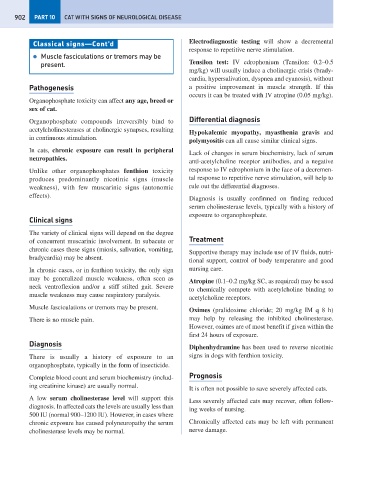Page 910 - Problem-Based Feline Medicine
P. 910
902 PART 10 CAT WITH SIGNS OF NEUROLOGICAL DISEASE
Classical signs—Cont’d Electrodiagnostic testing will show a decremental
response to repetitive nerve stimulation.
● Muscle fasciculations or tremors may be
present. Tensilon test: IV edrophonium (Tensilon: 0.2–0.5
mg/kg) will usually induce a cholinergic crisis (brady-
cardia, hypersalivation, dyspnea and cyanosis), without
Pathogenesis a positive improvement in muscle strength. If this
occurs it can be treated with IV atropine (0.05 mg/kg).
Organophosphate toxicity can affect any age, breed or
sex of cat.
Organophosphate compounds irreversibly bind to Differential diagnosis
acetylcholinesterases at cholinergic synapses, resulting
Hypokalemic myopathy, myasthenia gravis and
in continuous stimulation.
polymyositis can all cause similar clinical signs.
In cats, chronic exposure can result in peripheral
Lack of changes in serum biochemistry, lack of serum
neuropathies.
anti-acetylcholine receptor antibodies, and a negative
Unlike other organophosphates fenthion toxicity response to IV edrophonium in the face of a decremen-
produces predominantly nicotinic signs (muscle tal response to repetitive nerve stimulation, will help to
weakness), with few muscarinic signs (autonomic rule out the differential diagnoses.
effects).
Diagnosis is usually confirmed on finding reduced
serum cholinesterase levels, typically with a history of
exposure to organophosphate.
Clinical signs
The variety of clinical signs will depend on the degree
of concurrent muscarinic involvement. In subacute or Treatment
chronic cases these signs (miosis, salivation, vomiting,
Supportive therapy may include use of IV fluids, nutri-
bradycardia) may be absent.
tional support, control of body temperature and good
In chronic cases, or in fenthion toxicity, the only sign nursing care.
may be generalized muscle weakness, often seen as
Atropine (0.1–0.2 mg/kg SC, as required) may be used
neck ventroflexion and/or a stiff stilted gait. Severe
to chemically compete with acetylcholine binding to
muscle weakness may cause respiratory paralysis.
acetylcholine receptors.
Muscle fasciculations or tremors may be present.
Oximes (pralidoxime chloride; 20 mg/kg IM q 8 h)
There is no muscle pain. may help by releasing the inhibited cholinesterase.
However, oximes are of most benefit if given within the
first 24 hours of exposure.
Diagnosis
Diphenhydramine has been used to reverse nicotinic
There is usually a history of exposure to an signs in dogs with fenthion toxicity.
organophosphate, typically in the form of insecticide.
Complete blood count and serum biochemistry (includ- Prognosis
ing creatinine kinase) are usually normal.
It is often not possible to save severely affected cats.
A low serum cholinesterase level will support this
Less severely affected cats may recover, often follow-
diagnosis. In affected cats the levels are usually less than
ing weeks of nursing.
500 IU (normal 900–1200 IU). However, in cases where
chronic exposure has caused polyneuropathy the serum Chronically affected cats may be left with permanent
cholinesterase levels may be normal. nerve damage.

